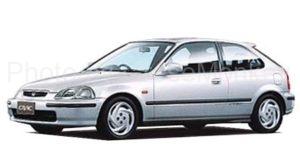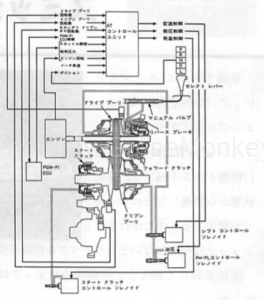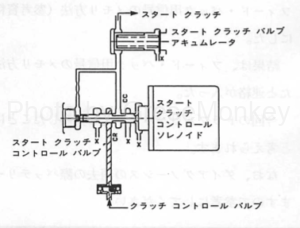1996 model: Honda Civic model: E-EK 3 engine model: D15B transmission model: M4VA mileage: 65,000km

Troubles of multimatic · transmission
A shock is generated from the transmission when starting from the stopped state. Also in the trouble that shock does not occur during running, the symptom occurs after exchanging the battery. It was that.
Start clutch
In this multimatic transmission, a start clutch is attached instead of a torque converter.
The control of the start clutch is controlled by the start clutch control solenoid, it is set to weak creep condition when stepping on the brake pedal, strong creep condition when releasing the brake pedal to ensure smooth start ing. (See Reference Material 1)
Therefore, when removing the battery or the backup fuse, the memory of the feedback signal of the start clutch control is erased and it is not possible to start smoothly. This is the cause of this shock at start.
Therefore, by carrying out the work according to the memory method of this feedback signal (reference material 2), it is possible to reduce the shock at the time of starting and return it to normal.
As a cause of the problem this time, the memory of the feedback signal was erased by replacing the battery, so it is considered that a shock occurred from the transmission at the start.
When battery terminals are removed in battery replacement, diagnosis, code erase, etc., the work of Reference Material 2 is required. The outline of the multimatic transmission and the memory method of the signal for feedback of the start clutch are shown below.
Reference material 1: Honda · Multimatic · transmission overview
AT control unit input / output and control

When the intention of the driver and information from various sensors are input to the AT control unit, the solenoid is operated according to the situation, and the shift control, the side pressure control, and the start control are performed.
- When the desired shift range of the intention of the driver is selected by the select lever, the shift position signal enters the AT control unit.
- At the same time, the manual valve connected by the select lever and the control cable operates to connect the forward clutch or the reverse brake.
- In this state, the engine power is transmitted to the drive pulley and is transmitted to the driven pulley via the metal belt. After the forward clutch / reverse brake is activated, the start control of the AT control unit activates the start clutch control solenoid, the start clutch is connected and travels.
- During traveling, the AT control unit operates the shift control solenoid and the side pressure control solenoid according to information such as current engine rotation, throttle opening degree, vehicle speed, etc., so that the drive pulley and the driven pulley Control the ratio.
Start control

In order to establish both smooth running without shift shock and balance between running and fuel economy, the transmission capacity of the start clutch is controlled by the hydraulic pressure applied to the clutch piston.
Although the hydraulic pressure applied to the start clutch is supplied via the start clutch control valve, the start clutch control valve is controlled by the start clutch control solenoid driven by the AT control unit, and the hydraulic pressure Is supplied. As a result, smooth start and optimum creep are established as in the torque converter except for the N and P positions.
In addition, the AT control unit memorizes the manifold negative pressure (PB) at the N position in order to prevent shocks and engine stalls at the time of starting, and when the shift to the D position is made, the AT control unit sets the start clutch This control pressure is controlled.
In securing optimum creep, weak creep is set when stepping on the brake pedal at the D position (D, S, E mode) and strong creep at the time of releasing the brake pedal for smooth reduction of idle vibration and fuel economy We have taken off.
Reference material 2: Start clutch control
Memory method for feedback signal
- Applicable model list 1
| CIVIC | EK3-1105659 until EK3-1105991 until(3stage VTEC) |
| CIVIC・FERIO | EK3-3114078 until EK3-3114352 until(3stage VTEC) |
| INTEGRA SJ | EK3-5100139 until EK3-5100209 until(3stage VTEC) |
- When the battery and the backup fuse are removed, the memory of the feedback signal of the start clutch control is also erased.
- If you remove the battery and the backup fuse, store it in the feedback signal and AT control unit according to the following procedure.
- If one of the following items also applies, scale the feedback signal to the AT control unit.
- Exchange of AT control unit
- Replacing the transmission assembly
- Change start clutch assembly
- Replacement of lower valve body assembly
- Exchange of engine assy or OH
- procedure
- Hang the parking brake securely, and stop the wheel on the tire.
- Start the engine and warm up until the radiator fan operates twice
- The radiator fan operates again, and immediately after it stops (60 seconds or less) put it in the N position and idle the engine for 1 minute under the following conditions.
- Step on the brake pedal
- AC switch OFF
- Fan switch off
- Lighting switch OFF
- All other electrical components that can be turned off are turned off (no load condition)
- Set the shift position to D and idle the engine for 2 minutes under the same conditions as 3.
- Even if the engine water temperature is sufficiently high, when the ATF temperature is 40 ° C. or lower, it is impossible to store the feedback signal in the AT control unit.
- Perform work until correct starting clutch control is achieved
- It can be confirmed by the Honda PGM tester that the feedback signal is graduated in the AT control unit.
- Applicable model list 2
| CIVIC | from EK3-1105660 from EK3-1105992(3stageVTEC) |
| CIVIC・FERIO/td> | from EK3-3114079 from EK3-3114353(3stageVTEC) |
| INTEGRA SJ | from EK3-5100140 from EK3-5100210(3stageVTEC) |
- In this model, even if the battery and the backup fuse are removed, the memory of the feedback signal of the start clutch control is not erased.
- If one of the following items also applies, scale the feedback signal to the AT control unit.
- Exchange of AT control unit
- Replacing the transmission assembly
- Change start clutch assembly
- Replacement of lower valve body assembly
- Exchange of engine assy or OH
- procedure
- Start the engine and warm up until the radiator fan operates twice.
- The radiator fan operates again, and immediately after it stops (60 seconds or less) put it in the N position and idle the engine for 1 minute under the following conditions.
- Step on the brake pedal
- AC switch OFF
- Fan switch off
- Lighting switch OFF
- All other electrical components that can be turned off are turned off (no load condition)
- When traveling on a flat road and the vehicle speed reaches approximately 60 km / h, decelerate more than 5 seconds without releasing the accelerator pedal and stepping on the brake. This concludes the memory of the signal for feedback.
- After completing the memory, run test and confirm that there is no stall or start failure.
- If there is an engine stall or start failure, try to store the feedback signal again.
- It can be confirmed by the Honda PGM tester that the feedback signal is graduated in the AT control unit.